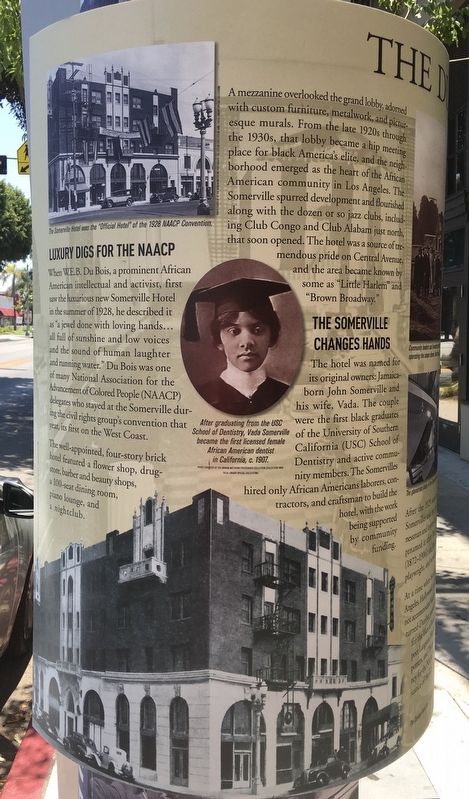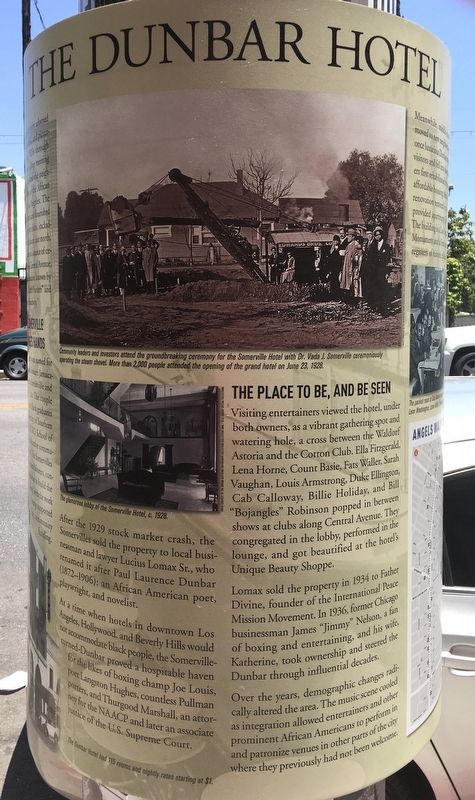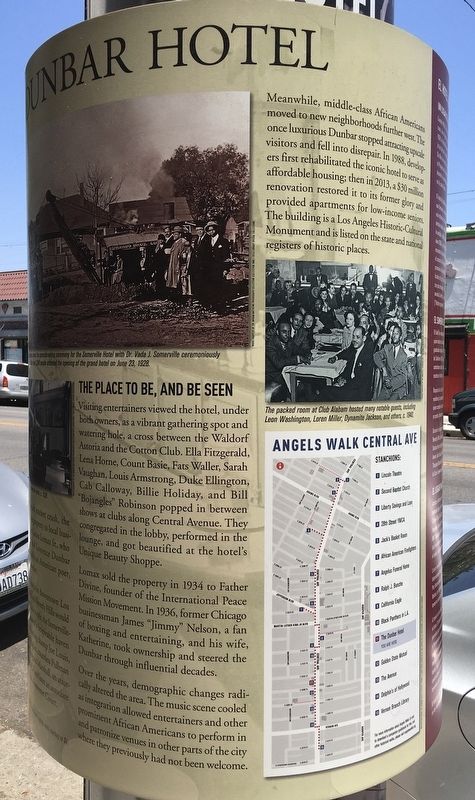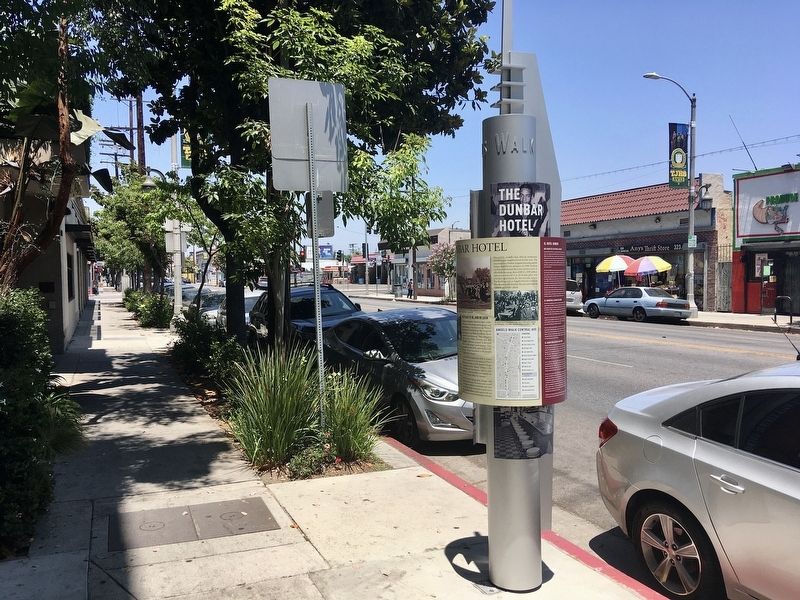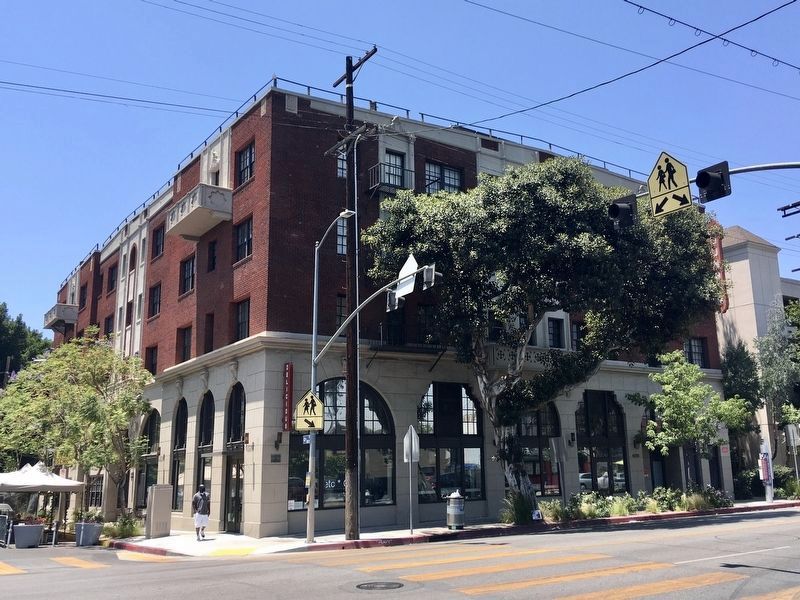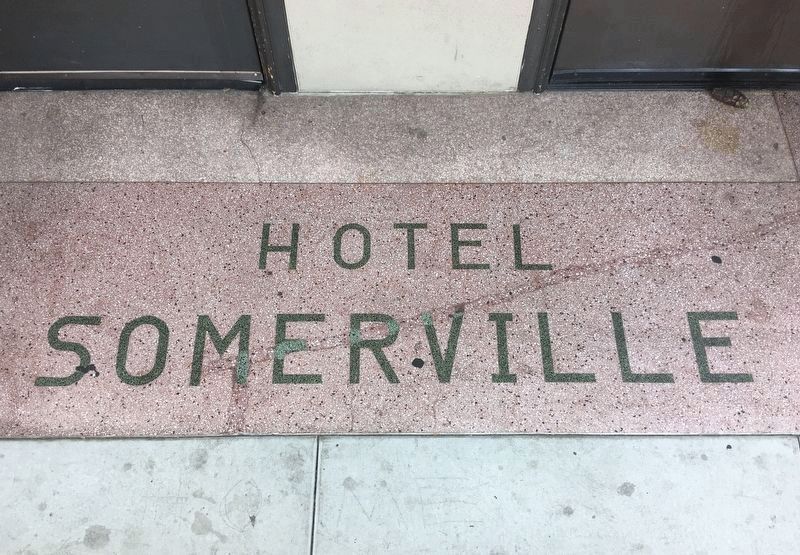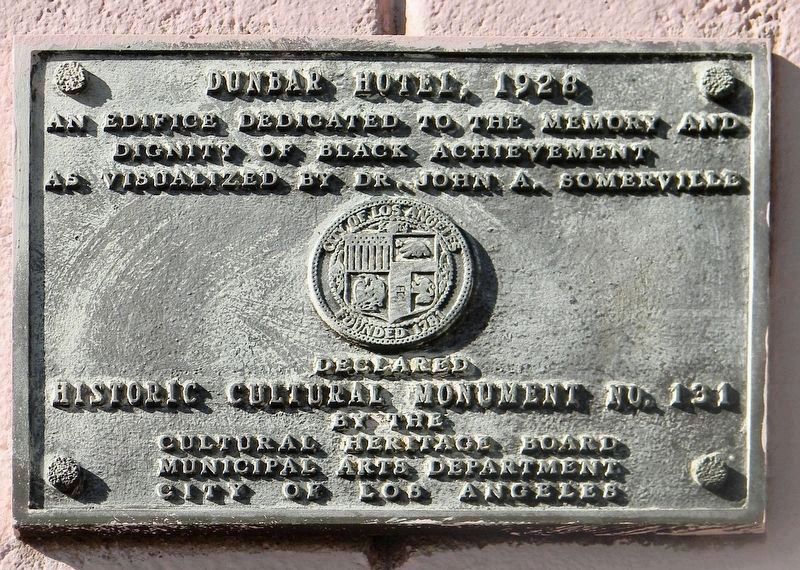South Los Angeles in Los Angeles County, California — The American West (Pacific Coastal)
Dunbar Hotel
Luxury Digs for the NAACP
When W.E.B. Du Bois, a prominent African American intellectual and activist, first saw the luxurious new Somerville Hotel in the summer of 1928, he described it as "a jewel done with loving hands... all full of sunshine and low voices and the sound of human laughter and running water." Du Bois was one of many National Association for the Advancement of Colored People (NAACP) delegates who stayed at the Somerville during the civil rights group's convention that year, its first on the West Coast. The well-appointed, four-story brick hotel featured a flower shop, drug-store, barber and beauty shops, a 100-seat dining room, piano lounge, and a nightclub.
A mezzanine overlooked the grand lobby, adorned with custom furniture, metalwork, and picturesque murals. From the late 1920s through the 1930s, that lobby became a hip meeting place for black America's elite, and the neigh-borhood emerged as the heart of the African American community in Los Angeles. The Somerville spurred development and flourished along with the dozen or so jazz clubs, including Club Congo and Club Alabam just north, that soon opened. The hotel was a source of tremendous pride on Central Avenue, and the area became known by some as "Little Harlem" and "Brown Broadway."
The Somerville Changes Hands
The hotel was named for its original owners: Jamaica-born John Somerville and his wife, Vada. The couple were the first black graduates of the University of Southern California (USC) School of Dentistry and active community members. The Somervilles hired only African American laborers, contractors, and craftsmen to build the hotel, with the work being supported by community funding.
After the 1929 stock market crash, the Somervilles sold the property to local businessman and lawyer Lucius Lomax Sr., who renamed it after Paul Laurence Dunbar (1872-1906): an African American poet, playwright, and novelist. At a time when hotels in downtown Los Angeles, Hollywood, and Beverly Hills would not accommodate black people, the Somerville-turned-Dunbar proved a hospitable haven for the likes of boxing champ Joe Louis, poet Langston Hughes, countless Pullman porters, and Thurgood Marshall, an attorney for the NAACP and later an associate justice of the U.S. Supreme Court.
The Place to Be, and be Seen
Visiting entertainers viewed the hotel, under both owners, as a vibrant gathering spot and watering hole, a cross between the Waldorf Astoria and the Cotton Club. Ella Fitzgerald, Lena Horne, Count Basie, Fats Waller, Sarah Vaughan, Louis Armstrong, Duke Ellington, Cab Calloway, Billie Holiday, and Bill "Bojangles" Robinson popped in between shows at clubs along Central Avenue. They congregated in the lobby, performed in the lounge, and got beautified at the hotel's Unique Beauty Shoppe. Lomax sold the property in 1934 to Father Divine, founder of the International Peace Mission Movement. In 1936, former Chicago businessman James "Jimmy" Nelson, a fan of boxing and entertaining, and his wife, Katherine, took ownership and steered the Dunbar through influential decades. Over the years, demographic changes radically altered the area. The music scene cooled as integration allowed entertainers and other prominent African Americans to perform in and patronize venues in other parts of the city where they previously had not been welcome.
Meanwhile, middle-class African Americans moved to new neighborhoods further west. The once luxurious Dunbar stopped attracting upscale visitors and fell into disrepair. In 1988, developers first rehabilitated the iconic hotel to serve as affordable housing; then in 2013, a $30 million renovation restored it to its former glory and provided apartments for low-income seniors. The building is a Los Angeles Historic-Cultural Monument and is listed on the state and national registers of historic places.
Erected by City of Los Angeles. (Marker Number 131.)
Topics and series. This historical marker is listed in these topic lists: African Americans • Arts, Letters, Music • Entertainment. In addition, it is included in the Los Angeles Historic-Cultural Monument series list. A significant historical year for this entry is 1928.
Location. 34° 0.418′ N, 118° 15.396′ W. Marker is in Los Angeles, California, in Los Angeles County. It is in South Los Angeles. Marker is at the intersection of Central Avenue and 42nd Place, on the right when traveling south on Central Avenue. Touch for map. Marker is at or near this postal address: 4225 S Central Ave, Los Angeles CA 90011, United States of America. Touch for directions.
Other nearby markers. At least 8 other markers are within walking distance of this marker. Apex / Club Alabam (a few steps from this marker); The Downbeat Club (within shouting distance of this marker); Golden State Mutual (within shouting distance of this marker); Central Avenue Historic District (about 600 feet away, measured in a direct line); The Los Angeles Sentinel (about 600 feet away); Black Panthers in L.A. (about 700 feet away); California Eagle (approx. 0.2 miles away); Dolphin’s of Hollywood (approx. 0.2 miles away). Touch for a list and map of all markers in Los Angeles.
Also see . . . Angels Walk L.A. Self-guided walking tours of historic neighborhoods in Los Angeles. The Dunbar Hotel marker is part of the Central Avenue walk. (Submitted on January 31, 2022.)
Credits. This page was last revised on June 22, 2023. It was originally submitted on January 30, 2022, by Craig Baker of Sylmar, California. This page has been viewed 261 times since then and 29 times this year. Photos: 1, 2, 3, 4, 5, 6, 7. submitted on January 30, 2022, by Craig Baker of Sylmar, California.
